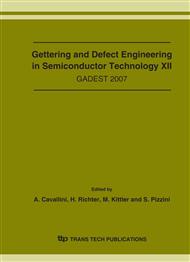p.399
p.405
p.413
p.419
p.425
p.431
p.437
p.443
p.449
Investigation of the Hydrogen Transport Processes in Crystalline Silicon of n-Type Conductivity
Abstract:
The silicon substrates were hydrogenated at approximately room temperature and hydrogen concentration profiles vs. depth have been measured by SIMS. Czochralski grown (CZ) wafers, both n- and p-type conductivity, were used in the experiments under consideration. For analysis of hydrogen transport processes and quasichemical reactions the model of hydrogen atoms diffusion and quasichemical reactions is proposed and the set of equations is obtained. The developed model takes into account the formation of bound hydrogen in the near surface region, hydrogen transport as a result of diffusion of hydrogen molecules 2 H , diffusion of metastable complexes * 2 H and diffusion of nonequilibrium hydrogen atoms. Interaction of 2 H with oxygen atoms and formation of immobile complexes “oxygen atom - hydrogen molecule” (O - H2 ) is also taken into account to explain the hydrogen concentration profiles in the substrates of n-type conductivity. The computer simulation based on the proposed equations has shown a good agreement of the calculated hydrogen profiles with the experimental data and has allowed receiving a value of the hydrogen molecules diffusivity at room temperature.
Info:
Periodical:
Pages:
425-430
Citation:
Online since:
October 2007
Authors:
Keywords:
Price:
Сopyright:
© 2008 Trans Tech Publications Ltd. All Rights Reserved
Share:
Citation:


